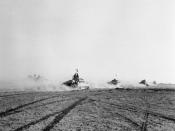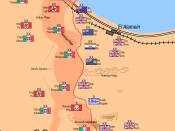The Battle of El Alamein, started either between October 23rd or November 5th in 1942. This battle was one of the largest battles involving the western allies in the whole of the war with Germany. El Alamein was part of the chain of battles that saw the British Common wealth forces advancing across the coastal plain and desert hinterland of North Africa from 1940 to 1943. The prize for the Axis (German and Italian forces under the command of the German general, Erwin Rommel) was Egypt and the Suez Canal. The destruction of the Axis forces in the Theatre was the focus of Allied operations. El Alamein was, in effect the closest the Axis came to achieving their goal. Once that battle was over, the Axis forces were in continual retreat until finally destroyed, in Tunisia on 11 May 1943, by the westward advancing 8th Army and the Allied Forces coming east from the Torch Landings.
While perhaps too much has been made of the battle of El Alamein - including such clearly jingoistic assessments that it was the turning point in the war - the battle was very important for a number of reasons. It was the battle that reignited Bernard Montgomery's career, with him eventually rising to the highest rank in the British Army and to command Allied land forces in the D-Day landings. It was an early rehearsal for the type of joint operations that were to become standard allied operating procedures in north west Europe following the D-Day invasion. Furthermore, it was the first large-scale battle fought by a British Army in the desert in which all elements in the Army fought to the same plan and same timetable, as a co-ordinated force. Ironically, in many ways, the battle was more reminiscent of the large...


